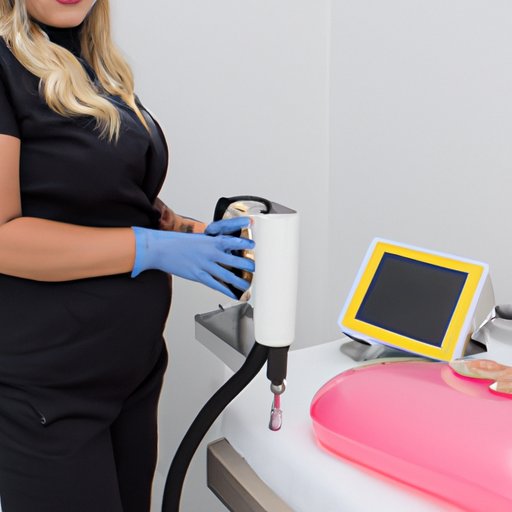Introduction
Liposuction is a popular body contouring procedure used to reduce localized fat deposits in specific areas of the body. It can help you achieve a slimmer, more proportionate appearance and improve your overall body shape. But how does liposuction work? In this article, we’ll explore the science and mechanics of liposuction and provide a comprehensive guide on how to prepare for the procedure, what to expect during the procedure, and tips for maintaining results after the procedure.

Exploring the Science and Mechanics of Liposuction
The American Society of Plastic Surgeons (ASPS) defines liposuction as “the surgical removal of fat deposits that are resistant to diet and exercise.” This procedure uses a small, hollow tube called a cannula that is inserted beneath the skin. The cannula is attached to a vacuum device that suctions out the fat cells. Liposuction is commonly used to remove excess fat from the abdomen, thighs, buttocks, arms, neck, and face.
There are several different types of liposuction techniques, including traditional liposuction, tumescent liposuction, ultrasound-assisted liposuction, laser-assisted liposuction, and power-assisted liposuction. Traditional liposuction involves making small incisions in the skin and then inserting a cannula to suction out the fat. Tumescent liposuction is similar to traditional liposuction but involves injecting a large amount of fluid into the area before suctioning out the fat. Ultrasound-assisted liposuction uses an ultrasonic device to break down the fat cells before they are suctioned out. Laser-assisted liposuction uses lasers to melt the fat before it is removed. Power-assisted liposuction uses a rapidly vibrating cannula to break up and suction out the fat.
A Comprehensive Guide to Liposuction Procedures
If you’re considering liposuction, it’s important to understand all the steps involved in the procedure. Here’s a step-by-step guide on how to prepare for a liposuction procedure:
- Schedule a consultation with your plastic surgeon to discuss your goals and expectations.
- Get a physical exam to make sure you are healthy enough for the procedure.
- Follow all pre-operative instructions given by your doctor, such as avoiding certain medications or supplements.
- Stop smoking at least two weeks before the procedure.
- Avoid alcohol for at least one week before the procedure.
Once you’ve prepared for the procedure, your doctor will explain the different methods of liposuction and discuss the cost and recovery time. Generally, the cost of liposuction depends on the type of procedure, the number of areas treated, and the amount of fat being removed. Recovery time varies depending on the type of procedure and the size of the area being treated. Most patients can return to their normal activities within a few days to a week.

How Liposuction Can Help You Achieve Your Body Goals
Liposuction can help you achieve a more proportionate body shape and improve your overall appearance. According to a study published in the International Journal of Surgery Case Reports, “Liposuction has been shown to be a safe and effective method for body contouring and fat removal with minimal complications.”
Here are some tips for maintaining results after liposuction:
- Maintain a healthy diet and exercise regularly.
- Drink plenty of water to stay hydrated.
- Avoid gaining too much weight.
- Wear compression garments to help reduce swelling and support the treated area.
What to Expect During a Liposuction Procedure
During the liposuction procedure, your doctor will make small incisions in the targeted area and insert the cannula. The cannula will suction out the fat cells, which will be removed from the body through a drainage tube. The entire procedure usually takes between one and three hours, depending on the size of the area being treated.
After the procedure, you may experience some bruising, swelling, and soreness in the treated area. Your doctor may recommend taking pain medication and wearing a compression garment to help reduce swelling and support the area while it heals. Most patients can return to their normal activities within a few days to a week.

Understanding the Benefits and Risks of Liposuction
As with any medical procedure, there are both benefits and risks associated with liposuction. The main advantages of liposuction include improved body contour, reduced fat deposits, and improved self-confidence. However, there are also potential risks, such as infection, bleeding, scarring, and nerve damage.
It’s important to talk to your doctor about the potential benefits and risks of liposuction before deciding if it’s right for you. Your doctor can help you understand the risks and recommend ways to minimize them.
Conclusion
Liposuction is a body contouring procedure used to reduce localized fat deposits in specific areas of the body. This article explored the science and mechanics of liposuction, provided a comprehensive guide on how to prepare for the procedure, and discussed the potential benefits and risks associated with the procedure. If you’re considering liposuction, it’s important to speak with your doctor to determine if it’s right for you.
(Note: Is this article not meeting your expectations? Do you have knowledge or insights to share? Unlock new opportunities and expand your reach by joining our authors team. Click Registration to join us and share your expertise with our readers.)
